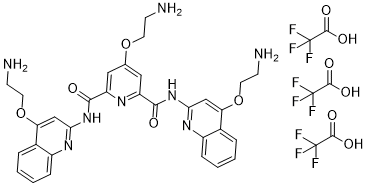All AbMole products are for research use only, cannot be used for human consumption.

Pyridostatin Trifluoroacetate Salt is a G-quadruplexe stabilizer, with a Kd of 490 nM. Pyridostatin stabilizes G-quadruplexes (G4s) in cells and elicits a DNA damage response by causing the formation of DNA double strand breaks (DSB). Pyridostatin promotes growth arrest in human cancer cells by inducing replication- and transcription-dependent DNA damage. Pyridostatin targets gene bodies containing clusters of sequences with a propensity for G-quadruplex formation. Pyridostatin (PDS) shows neurotoxic activity against primary cortical neurons at 0.01-5 μM, causes DNA double-strand breaks (DSBs) at 1 μM, downregulates BRCA1 in neurons at 1, 2 or 5 μM.
CAS# 1085412-37-8(free base)
| Cell Experiment | |
|---|---|
| Cell lines | MRC-5–SV40 cells and various cancer cell lines |
| Preparation method | Cells are plated at equal confluence and are left either untreated or were treated with 2 μM pyridostatin continually during the indicated time before harvesting the cells. Cells from individual plates are trypsinized and counted in a Coulter counter. Graphs represent the total cell numbers at each time interval, and the error bars represent the s.e.m. Data represent three independent experiments. |
| Concentrations | 10 μM |
| Incubation time | 48 h |
| Animal Experiment | |
|---|---|
| Animal models | |
| Formulation | |
| Dosages | |
| Administration | |
| Molecular Weight | 938.72 |
| Formula | C37H35F9N8O11 |
| CAS Number | 1472611-44-1 |
| Solubility (25°C) | DMSO: ≥ 90 mg/mL |
| Storage |
Powder -20°C 3 years ; 4°C 2 years In solvent -80°C 6 months ; -20°C 1 month |
| Related DNA/RNA Synthesis Products |
|---|
| Deoxyribonucleic Acid (from Salmon sperm)
Deoxyribonucleic Acid (from Salmon sperm) can be used as a research reagent, widely used in molecular biology, pharmacology and other scientific research. |
| GSK4418959
GSK4418959 (IDE275) is a non-covalent, reversible, selective and orally active WRN helicase inhibitor. GSK4418959 inhibits ATPase and DNA unwinding functions in an ATP-competitive manner. |
| Dencatistat
Dencatistat (P115) is an inhibitor of Cytidine Triphosphate Synthase 1 (CTPS1) with an IC50 value of ≤ 0.1 μM. |
| Antipain dihydrochloride
Antipain dihydrochloride is a protease inhibitor. Antipain dihydrochloride inhibits N-methyl-N'-nitro-N-nitrosoguanidine (MNNG)-induced transformation and increases chromosomal aberrations. Antipain dihydrochloride also restricts uterine DNA synthesis and function in mice. |
| Tetrahydrouridine
Tetrahydrouridine (THU) is potent inhibitor of cytidine deaminase (CDA), which competitively blocks the enzyme's active site more effectively than intrinsic cytidine. |
All AbMole products are for research use only, cannot be used for human consumption or veterinary use. We do not provide products or services to individuals. Please comply with the intended use and do not use AbMole products for any other purpose.


Products are for research use only. Not for human use. We do not sell to patients.
© Copyright 2010-2024 AbMole BioScience. All Rights Reserved.
